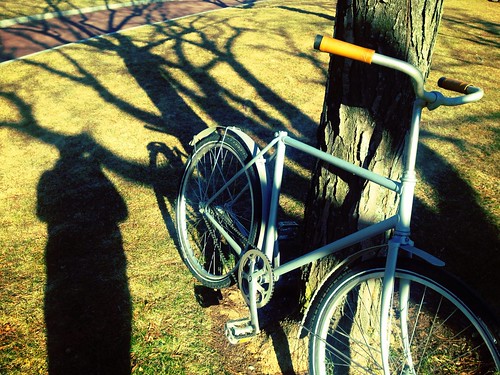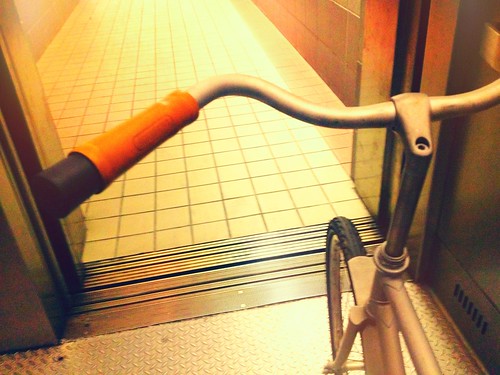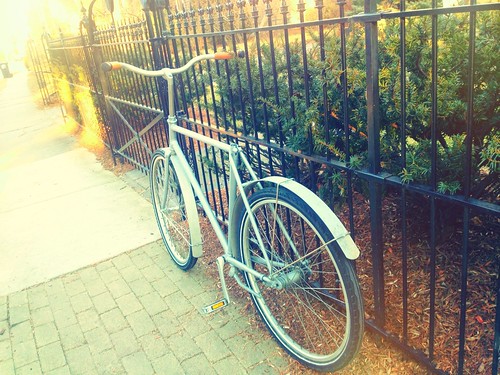
It's been raining here all week, so the timing seems right to review some raincoats. For three years now I've been looking for a lightweight, waterproof, breathable raincoat that works well on a city bike, but found nothing. Now I've suddenly come across two. On the left is the Succinct Trench by Nau, purchased by me a few months ago via a discount website. On the right is the Ride On Rain Jacket by Lululemon, sent to me for review by the manufacturer. Both raincoats fit my requirements well.
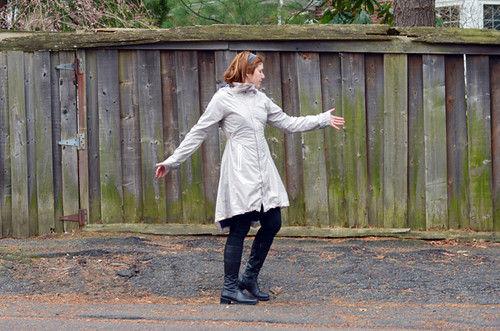
The Lululemon "Ride On" Rain Jacket is a rather avant-garde looking raincoat that hits a few inches above the knees in the front and an inch or so below the back of the knees in the rear. It has the same Edwardian theme as the blazer reviewed earlier, but here it is consistent and harmonious throughout the garment. The jacket is very thin and feels suitable for temperatures in the mid 40°s - mid 70°s Fahrenheit.
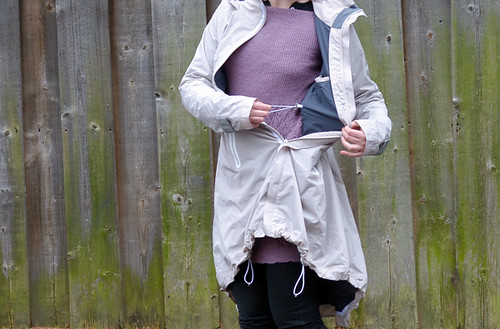
The jacket is waterproof and breathable,lined with a soft, thin fabricthroughout. Lululemon uses cryptic proprietary names to describe their fabrics, and the stuff this jacket is made of is called "atmosphere." It is crinkly and easy to scrunch up and stuff into a pannier when not in use. It weighs very little. An inner drawcord at the waist makes the fit of this jacket adjustable. Overall the fit is pretty loose, but tightening the drawcord gives it a tailored, flattering look. Another drawcord controls the hem.
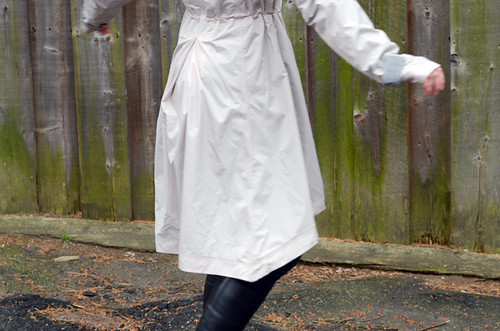
When the hem is let out, it is pretty flowy. Tightening the drawcord offers better protection from the rain.

The sleeves are extra long, featuring cuffs with reflective detailing.

There is an inner and an outer zipper, the purpose of which I do not entirely understand. Lululemon calls this a "double zipper." However, neither of them are two-way, and the jacket cannot be unzipped from the bottom.
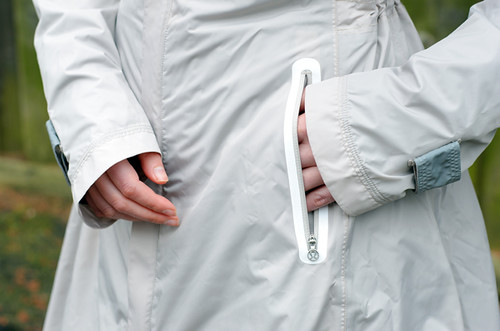
The front pockets have smallish zippered openings outlined with reflective ribbon They are very roomy inside and are lined with a soft, pleasant fabric. There is also an inner pocket.
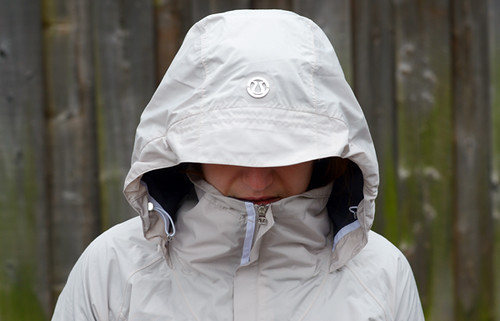
The collar zips up high and can be used in leu of a scarf. The hood is large enough to fit over a bicycle helmet, of so desired. It is is adjustable via a drawstring, but is not detachable.
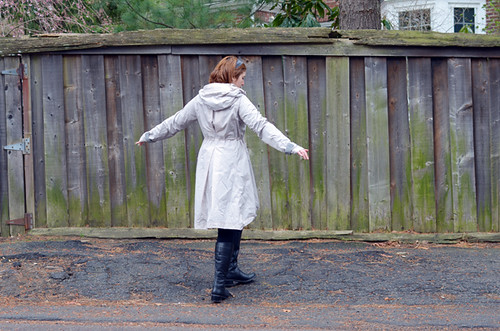
TheLululemon "Ride On" Rain Jacket works well for cycling because it is lightweight, waterproof, breathable, stretchy, makes minimal rustling noise, has longer than standard sleeves, and provides good rain coverage via a combination of its length and drawcord hem. At the same time it is sufficiently elegant to wear as part of an everyday, non-technical wardrobe. As far as criticisms: I found the fit of the hood to be less than optimal, with a slight tendency to obscure my peripheral vision unless I move it out of the way or push it back a bit. Hi-viz lovers might be disappointed by the subtlety of the reflective details, but this jacket is also available in orange (and black). The $298 price tag may or may not be a deal breaker, depending on what you are used to. And of course the flowing, Edwardian style is not everyone's cup of tea. Would I have bought this jacket for myself? Not at full retail price, but yes if it went on sale and if I did not already own the Nau trench (see below). After this review I will be giving it away locally. You can read another review of this jacket by Dottie on Let's Go Ride a Bike.
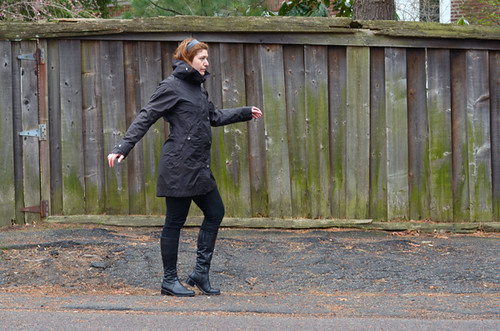 The Nau Succinct Trenchresembles a classic Barbour-style English field coat. It hits mid-thigh and is gently tailored at the waist. Made of an ultra-thin shell material, it is waterproof, breathable and lightweight,suitable for temperatures in the mid
The Nau Succinct Trenchresembles a classic Barbour-style English field coat. It hits mid-thigh and is gently tailored at the waist. Made of an ultra-thin shell material, it is waterproof, breathable and lightweight,suitable for temperatures in the mid40°s - mid 70°s Fahrenheit
. The fabric is described as "recycled polyester."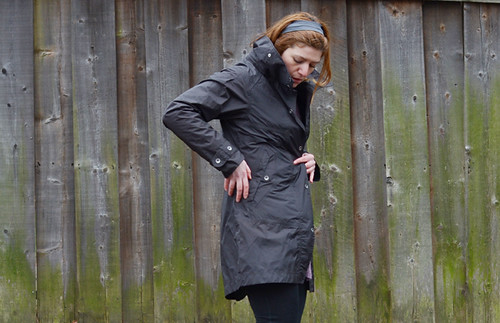
The jacket shown here is the model and the colour of the current model is a little different: The latter has black buttons instead of silver and a very subtle black-on-black plaid pattern. In all other ways they are the same (I asked the manufacturer).
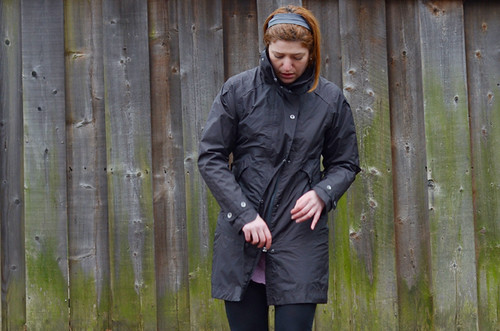
The Nau trench is simple, compact and decidedly utilitarian in design. Those who do not like to fuss with drawcords and adjust things back and forth, will enjoy its intuitive versatility.
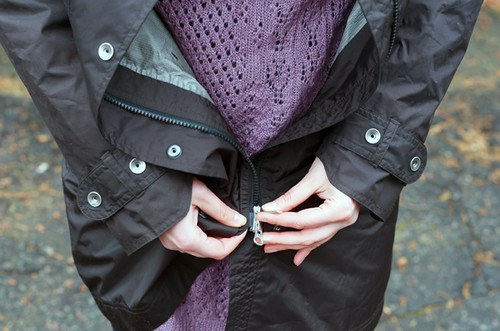
The two-way zipper and rear vent make it easy to adjust the width of the hem for pedaling, walking, and other activities .
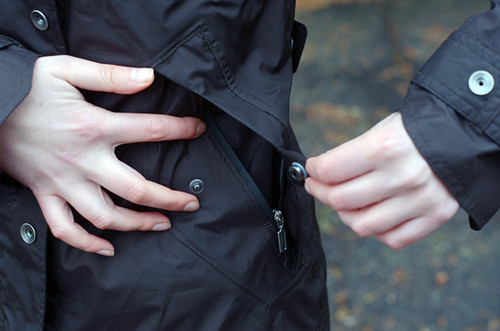
The roomy, covered pockets feature both zip and snap closure, allowing both easy access of weather-proofing.
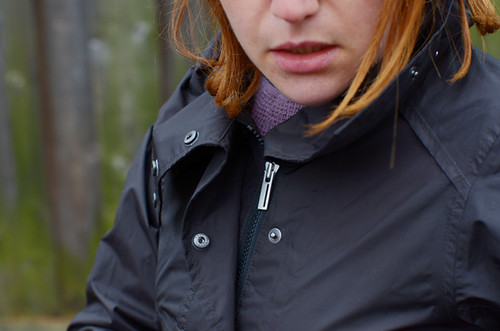
The stand-up collar can be buttoned up to protect the neck from rain and wind, or let out.

The waist is adjustable.
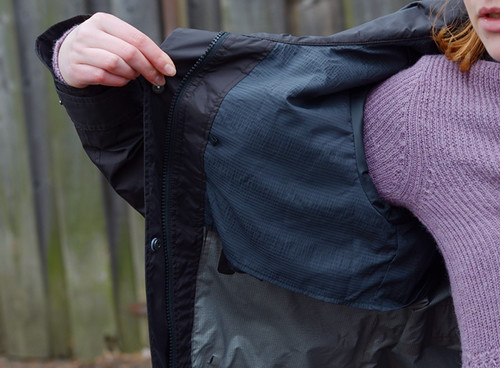
Only the upper 3rd of the trench is lined, reducing weight and bulk.
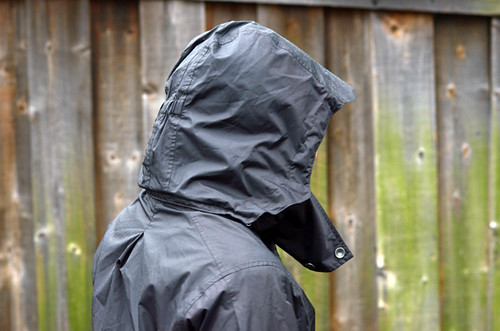
The detachable, visored hood features both a zipper,snap closure and a hidden draw-cord, allowing for a number of micro-adjustments for optimal fit.

The NauSuccinct Trench works well for cycling because it is lightweight, waterproof, breathable, easy to move in, makes minimal rustling noise, has longer than standard sleeves, and provides coverage of the derriere and upper thighs. A classic design, it is sufficiently elegant to wear as part of an everyday, non-technical wardrobe and is unlikely to go out of style over the next few years. The detachable hood offers extra versatility, and does not obscure peripheral vision. As far as criticisms: Making the trench slightly longer would provide better rain coverage for cyclists. Adding a few reflective elements will be attractive to those who require that their rain jacket be hi-viz. Personally I would love to see this jacket in a classic colour other than black - for instance olive green. The $275 price tag may or may not be a deal breaker, depending on what you are used to. I bought mine for 40% off via a discount retailer at the end of last season, and those who find the retail price too high can always wait, stalk, and do the same.
I find both the Nau Succinct Trench and the Lululemon Ride on Rain Jacket to be flattering, practical, and cycling-appropariate, assuming that you ride an upright bike and are looking for a raincoat that is suitable as everyday clothing. The Lululemon jacket is probably the more stylish of the two considering current trends, but it is also the more likely to look dated a couple of years down the road. For me, that skews things in favour of the Nau trench, but others' preferences may differ. Both raincoats are good examples of cycling-appropriate apparel. By comparison, my older raincoat is considerably bulkier and more constricting on the bike. I am glad to have finally found a replacement.
 I love to watch the kittens play and took this series of photos of them playing on the couch the other day. They have all kinds of toys but prefer to play with each other more than the toys. The gray kitten is about half the size of the black one but she can still hold her own when it comes to the wrestling matchs.
I love to watch the kittens play and took this series of photos of them playing on the couch the other day. They have all kinds of toys but prefer to play with each other more than the toys. The gray kitten is about half the size of the black one but she can still hold her own when it comes to the wrestling matchs.































 One of the streams/waterfalls that drop hundreds of feet down the mountain side along the Glacier Highway.
One of the streams/waterfalls that drop hundreds of feet down the mountain side along the Glacier Highway. The river of ice fills the valley below and continues on up and around the mountain peak on the left. Those black streaks are dirt and rocks that the glacier has picked up as it moves imperceptibly over the mountains.
The river of ice fills the valley below and continues on up and around the mountain peak on the left. Those black streaks are dirt and rocks that the glacier has picked up as it moves imperceptibly over the mountains. It would not be an easy task, if even possible, to hike over this.
It would not be an easy task, if even possible, to hike over this.  Crevasses and holes would make it a rather treacherous journey. These aren't just ripples in the surface, they are deep. Perhaps a hundred feet or more.
Crevasses and holes would make it a rather treacherous journey. These aren't just ripples in the surface, they are deep. Perhaps a hundred feet or more. Salmon Glacier from another turnout two miles north. The clouds and fog obscured the little bit of sun that occasionally came through.
Salmon Glacier from another turnout two miles north. The clouds and fog obscured the little bit of sun that occasionally came through. The Salmon Glacier is the fifth largest glacier in Canada and is a remnant of the last glaciation period which occurred 14,000 years ago. What I saw and what is shown here are but a very small portion of the glacier which extends way back beyond the horizon.
The Salmon Glacier is the fifth largest glacier in Canada and is a remnant of the last glaciation period which occurred 14,000 years ago. What I saw and what is shown here are but a very small portion of the glacier which extends way back beyond the horizon. The sun did make an appearance now and then and the rain finally stopped - briefly. Down in the valley and a few miles to the south are the towns of Hyder, Alaska and Stewart, British Columbia.
The sun did make an appearance now and then and the rain finally stopped - briefly. Down in the valley and a few miles to the south are the towns of Hyder, Alaska and Stewart, British Columbia.
